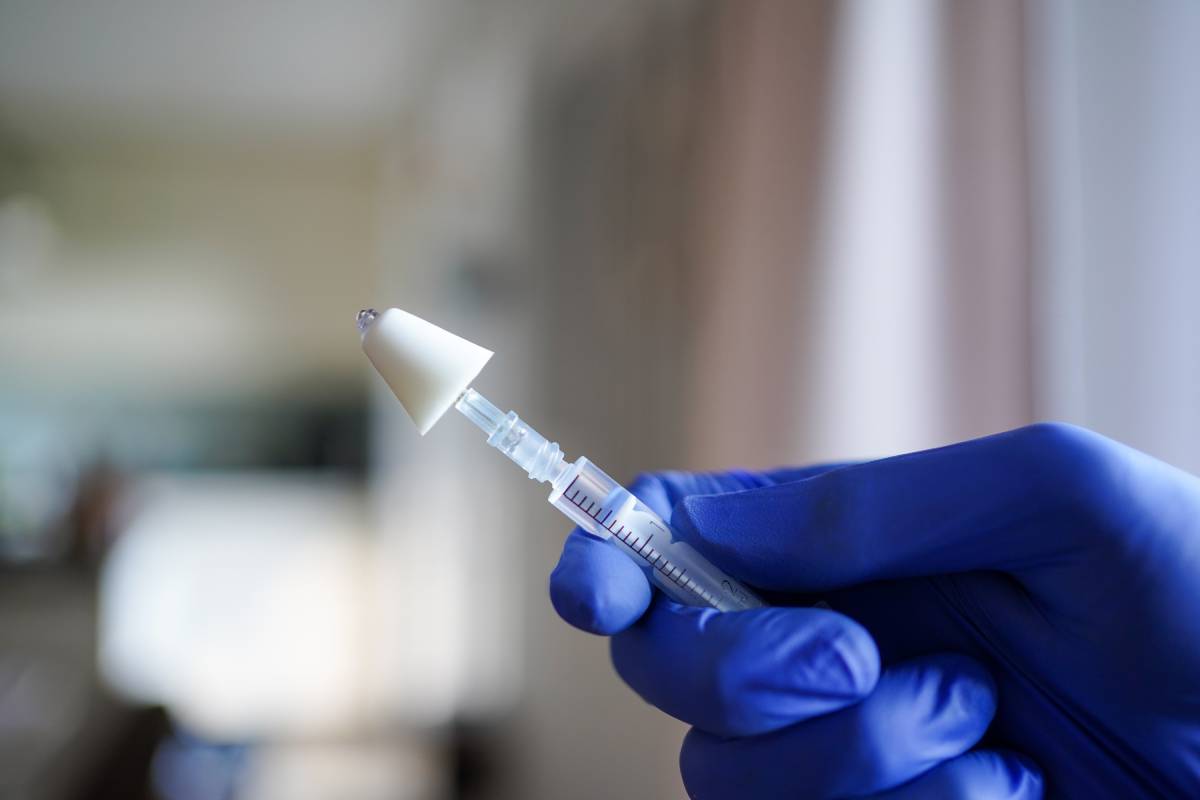Anesthesia Without a Needle

Many drugs used for anesthesia are typically administered by injection, but this can pose difficulties for medical practitioners [1]. Some patients may be afraid or phobic, while others may experience great pain as a result of a needle-based injection [2]. By eliminating the puncture phase, anesthesia without a needle can assuage the fears of needle-phobic patients and potentially avoid extra pain [1].
Various anesthetic techniques can be used instead of needle-administeredanesthesia. Practitioners can choose from an assortment of administration routes, including intranasal, oral, rectal, and epidermal avenues, though not all administration routes work for every level of anesthesia [3]. Anesthesia providers also have a diverse range of pharmacological options. Chloral hydrate, dexmedetomidine, and pentobarbital are just some of the medications that practitioners opting for the needle-free approach have used [4].
When making decisions about administration route, medication, and dosage, providers should consider the goals of the sedative method and the unique attributes of the agent [3]. They should also keep in mind whether analgesia is necessary [3]. If so, they should be acutely aware of the risks of combination therapy, particularly when combining benzodiazepines with opioids, to avoid adverse events such as hemodynamic instability and respiratory depression [3].
To choose between anesthesia techniques without a needle, practitioners should consult the sizeable body of research comparing the relative success levels of different techniques. One common needle-free approach involves the J-Tip, an FDA-approved sterile jet injector used to intradermally administer xylocaine [5]. Researchers have tested the J-Tip in various contexts to considerable success. For instance, Pelligra and colleagues used the J-Tip for intralesional injection of keloids in pediatric patients and noted how the technique contributed to low complication rates, pain, and anxiety among patients while being easy to use and cost-effective [5]. Similarly, Szmuk et al. detailed how the J-Tip has led to positive outcomes in other contexts, including digital ring block anesthesia administration, fine-needle aspiration cytology, and sentinel lymph node biopsy [2].
The Comfort-in injection system (CIS) is another alternative to traditional anesthesia that is used in dentistry [1]. The device involves a liquid jet that can be used to quickly insert an anesthetic solution into a perforation in the patient’s body [1]. It was recently tested in the pediatric dentistry context, specifically as a pain management technique during palatal infiltration anesthesia [1]. The results were promising: 77.1% of patients preferred CIS to traditional anesthesia and reported less pain than the traditional anesthesia group [1].
A final study worth highlighting focused on children, aged 0-8, receiving magnetic resonance imaging (MRI) [4]. MRIs can be challenging for young children, given that it requires them to lie still for extended periods of time [4]. In addition, many children do not respond well to needles in medical procedures. Consequently, the use of anesthesia techniques without a needle can help practitioners achieve clear imaging without subjecting children to unnecessary pain or anxiety [4]. In their meta-analysis, the researchers compared several needle-free anesthesia methods and found that oral chloral hydrate (alone or combined with intranasal dexmedetomidine), oral pentobarbital, inhaled sevoflurane, and intranasal dexmedetomidine combined with midazolam all contributed to high success rates [4]. However, they also noted that some techniques, such as chloral hydrate, may cause adverse events while others, like sevoflurane, can be invasive, so a practitioner should not rely on success rate alone in opting for one method over others [4].
In conclusion, practitioners seeking to administer anesthesia without using a needle have many options to choose from. When determining which technique is best for their patients, they should consider factors such as the anesthetic goal, risk of adverse events, success rates, and interactions with other therapies.
References
[1] E. Kaya and S. Yıldırım, “Effect of a needle-free system versus traditional anesthesia on pain perception during palatal injections in children,” International Journal of Paedriatric Dentistry, p. 1-9, September 2022. [Online]. Available: https://doi.org/10.1111/ipd.13028.
[2] P. Szmuk, E. Szmuk, and T. Ezri, “Use of needle-free injection systems to alleviate needle phobia and pain at injection,” Expert Review of Pharmacoeconomics & Outcomes Research, vol. 5, no. 4, p. 467-477, August 2005. [Online]. Available: https://doi.org/10.1586/14737167.5.4.467.
[3] B. Leverett and B. King, “Pediatric Sedation: A Comprehensive Review,” Trauma Reports, vol. 21, no. 6, p. 1-18, August 2005. [Online]. Available: https://bit.ly/3JthAd1.
[4] I. de Rover et al., “Needle-free pharmacological sedation techniques in paediatric patients for imaging procedures: a systematic review and meta-analysis,” British Journal of Anaesthesia, vol. 130, no. 1, p. 51-73, January 2023. [Online]. Available: https://doi.org/10.1016/j.bja.2022.09.007.
[5] A. Pelligra et al., “Needle-Free Injection of Steroids for Keloids: A Novel Approach to Management,” Plastic and Reconstructive Surgery – Global Open, vol. 10, no. 10S, p. 10, October 2022. [Online]. Available: https://doi.org/10.1097/01.GOX.0000898352.90595.83.